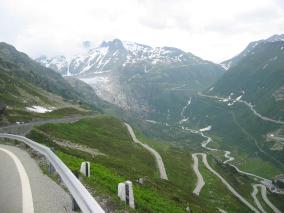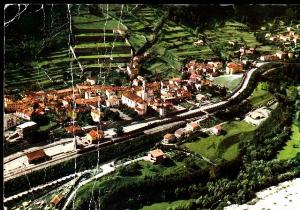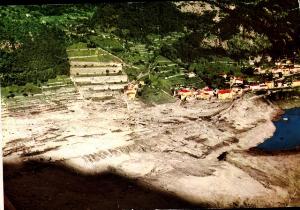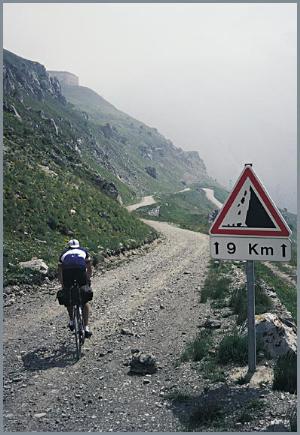The Axenstrasse is noted for its rugged cliffs that drop steeply to the dark green lake. The Gotthard railway lies below the road near the water, mostly in tunnels, while the road wound its way through short tunnels on the way to Flüelen in the Reuss valley. The Axenstrasse can best be appreciated from a bicycle with its view of towering snow capped peaks above the lake.
While the railway stayed mostly in tunnels, our road wound its way through short tunnels on our way to Flüelen at the end of the lake. It was along these cliffs that William Tell was said to have duped the Austrians, who had taken him captive and were returning by boat to their headquarters when a fierce storm arose.

We descended to Selva di Cadore (1336m) and headed east to Passo Staulanza (1773m) along the Torrente Fiorentina all the while heading straight for Monte Pelmo (3168m). The Staulanza is an easy pass and comes as a surprise because there is no apparent gap past Monte Pelmo. After a hairpin turn just before the mountain, the pass shows up unexpectedly.
Typical of the Dolomites, this route is a scenic wonder. We rode to Longarone (472m), notorious for the dam disaster at 22:42 on 09 October 1963 when the town was destroyed by a "tidal wave", that a landslide from Monte Toc (1921m) had forced over a dam and through a narrow gulch across from the town, to claim 1909 lives. Our hotel as, most in that area, had many before and after pictures on its walls.
[The following day] we started out under blue skies that gradually turned cloudy as the day passed. We crossed the valley and rode up the granite wall through tunnels as we headed to the gap of death for Longarone. Below, carved into the vertical wall, we saw the old road notched and tunneled into the gorge as we passed tunnel openings in our road. Then we saw the hollow arch of the dam, still intact, with only a bit of the rim cracked of on the far side. It is less than 50m across but at least three times that high, narrowing to almost nothing at its bottom.
After the last tunnel we emerged just above the dam that still has a bit of water between it and the mountain that slid into the former lake. A memorial chapel by Corbusier stands vigil over this disaster.


I rode along the Vermenagna River below the Tenda rail line, famous for being either in a tunnel or on a bridge most of the 80km from Borgo San Dalmazzo to Ventimiglia and Nice. The river and its tributaries had ripped out bridges and carried away parts of the road in recent floods. While the railway gained altitude in looping tunnels and bridges and vanished in the mountain for long stretches, I cruised up the 4% grade to Limone (990m), where the climb to the highway tunnel begins and the 8090m-long Tenda Railway Tunnel, completed in 1913, bores through the mountain to Vievola.
At 1279m the road enters the 3180m-long Tenda highway tunnel, which was completed in its present form in 1882. A sign with the "bicycles prohibited" icon stands at the tunnel portal, across from a small shop with refreshments and a good selection of local maps. Meanwhile, the old Tenda road, looking like a hotel driveway, takes off across the street.
This road had recently been repaved with smooth asphalt to the Tenda summit (1908m) where the view exposes a panorama greater than the altitude might suggest. Not only is the summit a national border but it seems to be a 100-year step back to a time before paved roads and comfortable hotels. Pavement ends here and baseball-sized gravel begins on the 19th century road of the south side. Partially collapsed stone roadhouses, that served travelers before the tunnel was built, lie along the road, while huge empty fortifications stand guard on the ridges above as sentinels of history.
Sixty or so hairpin turns descend steeply into the ravine of the Roya River. Many of the loose and deeply rutted turns are tough going even for a jeep. Although some curves had been paved with asphalt, most of it was gone by now, washed away by the rains that had damaged the highway below. Historic photographs of mule and horse teams, steam tractors, and solid-tired chain-driven trucks that once traveled this road make today's "hardships" pale in comparison.
I rode more carefully than usual because the deeply rutted turns defied crossing if taken on the wrong side of the road. Below, in the rocky gorge of the Roya River, I finally left the gravel and got on the swift smooth curves of the Tende highway, French Rt N204, where it emerges from the tunnel (1279m).
The railway emerges from its tunnel at Vievola (990m), only to vanish into a loop tunnel followed by many bridges as it descends to Tende (816m). The road gradient is about 8% here so it is not difficult to keep a good pace down into the Soarge Gorge. The road to the town of Soarge heads into a tunnel, and few windows reveal its route in the canyon wall as it climbs to Soarge, a strip of houses glued to the cliffs, some with more than a hundred meter freefall from their windows.
